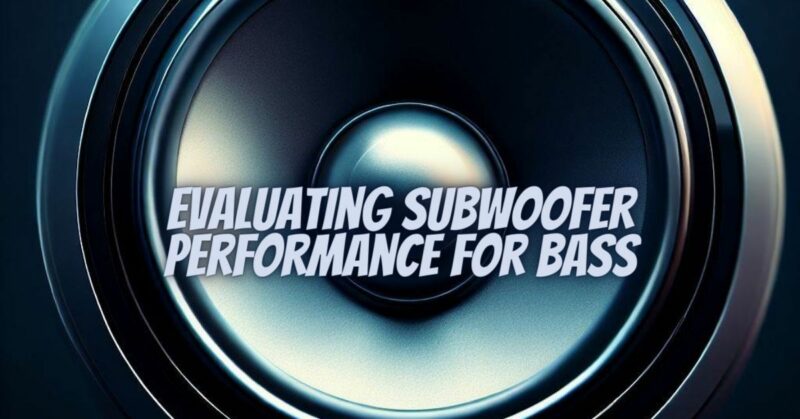Subwoofers are the unsung heroes of any audio system, responsible for delivering the low-frequency, earth-shaking bass that adds depth and power to your music, movies, and gaming experiences. Assessing subwoofer performance for bass is essential to ensure that it meets your expectations and complements your audio setup. In this article, we will explore the methods and techniques for accurately evaluating subwoofer performance and achieving the best possible bass output.
Understanding Subwoofer Performance
Before we delve into the evaluation process, let’s gain a better understanding of subwoofer performance and its key components:
- Frequency Response: Subwoofers are designed to handle low-frequency sounds. The frequency response indicates the range of frequencies a subwoofer can reproduce effectively. It is usually measured in Hertz (Hz).
- Power Handling: This specification represents the maximum power a subwoofer can handle without distortion or damage. It is typically measured in watts (W).
- Sensitivity: Sensitivity measures how efficiently a subwoofer converts electrical power into sound. Higher sensitivity ratings mean that the subwoofer can produce more sound with less power.
- Enclosure Type: Subwoofers can be housed in various types of enclosures, such as sealed, ported, or bandpass. The enclosure type influences the subwoofer’s bass characteristics, including tightness and resonance.
Methods for Evaluating Subwoofer Performance
- Listening Evaluation:
One of the most straightforward methods for assessing subwoofer performance is through listening evaluation. Follow these steps:
- Music Selection: Choose a variety of music tracks that feature deep bass. This will allow you to evaluate the subwoofer’s performance across different genres and styles.
- Proper Subwoofer Placement: Ensure that the subwoofer is correctly positioned within your room. Experiment with placement to find the location that provides the most balanced and immersive bass response.
- Listening Position: Sit in your primary listening position and adjust the subwoofer’s volume and settings to achieve a balanced and enjoyable bass experience.
- Deep Bass Test Tracks: Utilize tracks specifically designed to test subwoofer performance, often referred to as “bass demo tracks.” These tracks contain extremely low-frequency content that can reveal the subwoofer’s capabilities.
- Critical Listening: Pay close attention to the quality of the bass, including its depth, clarity, and impact. Note if the bass integrates seamlessly with the main speakers or if it overpowers the overall audio experience.
- Frequency Response Measurement:
For a more technical assessment of subwoofer performance, you can measure the frequency response using specialized equipment like an SPL (Sound Pressure Level) meter and measurement software:
- SPL Meter: Place an SPL meter at your listening position to measure sound levels accurately.
- Test Tones: Play a series of test tones or sine waves at various frequencies within the subwoofer’s range.
- Measurement Software: Use measurement software (e.g., Room EQ Wizard) to analyze the SPL levels at different frequencies. The resulting frequency response graph will show you how the subwoofer performs across the bass spectrum.
- Room Considerations: Keep in mind that room acoustics can influence measurement results. Conduct measurements at multiple listening positions and average the results for a more accurate assessment.
- Comparative Testing:
To evaluate a subwoofer’s performance in comparison to others, conduct comparative testing:
- A/B Testing: If possible, set up two or more subwoofers with different specifications or from different brands.
- Switch Between Subwoofers: Play the same bass-heavy content through each subwoofer individually and switch between them to hear the differences in bass quality, depth, and impact.
- Take Notes: Record your observations, paying attention to which subwoofer delivers the most satisfying bass output for your preferences.
- Professional Calibration:
For the most precise assessment and fine-tuning of your subwoofer’s bass performance, consider enlisting the services of a professional audio technician. They can analyze your room’s acoustics and use specialized equipment to calibrate your subwoofer for optimal bass performance in your specific listening environment.
Evaluating subwoofer performance for bass is crucial to ensuring that your audio system delivers deep, impactful, and immersive low-frequency sound. Whether you’re an audiophile, a home theater enthusiast, or a gamer, the ability to assess subwoofer performance allows you to customize your audio experience to match your preferences and the content you’re enjoying. By following the methods and techniques outlined in this guide, you can unlock the full potential of your subwoofer and enjoy bass that is powerful, clear, and perfectly suited to your listening environment.

